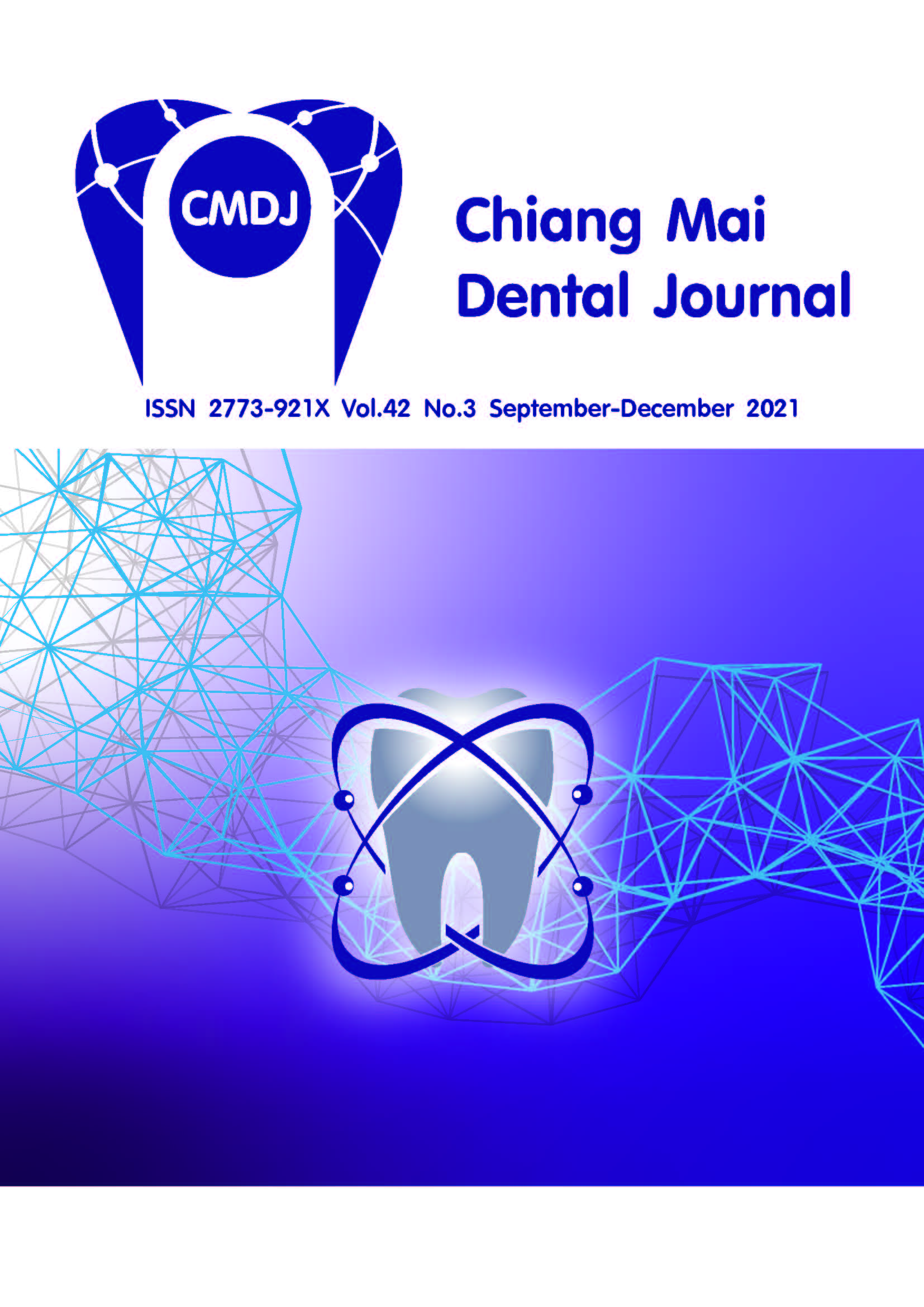Study of Flexural Properties between Domestic Glass Fibers Reinforced Polymethylmethacrylate and Dental Glass Fibers Reinforced Polymethylmethacrylate
Main Article Content
Abstract
The aim of this study was to examine the flexural properties of PMMA reinforced with domestic glass fibers compared to PMMA reinforced with dental glass fibers. Thirty-two PMMA bar specimens in the size of 10x64x3.2 mm3 (ISO 20795-1) were divided equally into 4 groups (eight specimens for each) according to the types of fibers: 1) no fibers 2) dental fibers 3) silane impregnated domestic glass fibers 4) non-silane impregnated domestic glass fibers. All specimens were subjected to 2,000 cycles of thermocycling. Flexural strength was determined using a three-point loading test set up at a crosshead speed of 5 mm/min by Universal Testing Machine Model 5566. Scanning electron microscopy was used to examine the microstructure of the cracked surface at 200X and 1000X. The results were analyzed by One-way ANOVA and Tukey HSD (α=0.05). Results: The silane impregnated domestic glass fibers demonstrated the highest flexural strength compared to the others while the non-impregnated domestic glass fibers had the lowest flexural strength. CONCLUSION Reinforcing PMMA with silane impregnated domestic glass fibers could improve its flexural strength. Keywords: Flexural Properties, Glass Fibers, Polymethylmethacrylate, Silane Coupling Agent
Article Details
References
Peyton FA. History of resins in dentistry. Dent Clin North Am 1975; 19(2): 211-222.
Narva KK, Lassila LV, Vallittu PK. The static strength and modulus of fiber reinforced den-ture base polymer. Dent Mater J 2005; 21(5): 421-428.
Stafford GD, Smith DC. Flexural fatigue tests of some denture base polymers. Br Dent J 1970; 128(9): 442-445.
Vallittu PK, Vojtkova H, Lassila VP. Impact strength of denture polymethyl me thacrylate reinforced with continuous glass fibers or metal wire. Acta Odontol Scand 1995; 53(6): 392-396.
Vuorinen A-M, Dyer SR, Lassila LVJ, Vallittu PK. Effect of rigid rod polymer filler on mechani-cal properties of poly-methyl methacrylate denture base material. Dent Mater J 2008; 24(5): 708-713.
John J, Gangadhar SA, Shah I. Flexural strength of heat-polymerized polymethyl methacry-late denture resin reinforced with glass, aramid, or nylon fibers. J Prosthet Dent 2001; 86(4): 424-427.
Kanie T, Fujii K, Arikawa H, Inoue K. Flexural properties and impact strength of denture base polymer reinforced with woven glass fibers. Dent Mater J 2000; 16(2): 150-158.
Garoushi S, Lassila LV, Tezvergil A, Vallittu PK. Load bearing capacity of fibre-reinforced and particulate filler composite resin combination. J Dent 2006; 34(3): 179-184.
Dyer SR, Lassila LV, Jokinen M, Vallittu PK. Effect of fiber position and orientation on frac-ture load of fiber-reinforced composite. Dent Mater J 2004; 20(10): 947-955.
Tezvergil A, Lassila LVJ, Vallittu PK. The effect of fiber orientation on the thermal expansion coefficients of fiber-reinforced composites. Dent Mater J 2003; 19(6): 471-477.
Vallittu P. Curing of a silane coupling agent and its effect on the transverse strength of au-topolymerizing polymethylmethacrylate—glass fibre composite. J Oral Rehabil 1997; 24(2): 124-130.
Homjunjeerung P. Effect of coupling agent on transverse strength of acrylic resin with glass fiber reinforced composite. CU Dent J 2551; (31): 349-358.
Nincharoen S, Prayadsab P, Arksornnukit M, Chaijareenont P. Effect of different alumina filler amounts reinforced into acrylic denture base on tensile bond strength between denture teeth and denture base. CM Dent J 2013; 34(2): 71-80.
Arksornnukit M, Takahashi H, Nishiyama N, Pavasant P. Effects of heat and pH in silanation process on flexural properties and hydrolytic durabilities of composite resin after hot water stor-age. Dent Mater 2004; 23(2): 175-179.
Bayne SC. Dental biomaterials: where are we and where are we going? J Dent Educ 2005; 69(5): 571-585.
Chaijareenont P, Takahashi H, Nishiyama N, Arksornnukit M. Effect of different amounts of 3-methacryloxypropyltrimethoxysilane on the flexural properties and wear resistance of alumina re-inforced PMMA. Dent Mater J 2012; 31(4): 623-628.
Chaijareenont P, Takahashi H, Nishiyama N, Arksornnukit M. Effects of silane coupling agents and solutions of different polarity on PMMA bonding to alumina. Dent Mater J 2012; 31(4): 610-616.
T. I. O. f. Standardization ,Reference number ISO/TS 20795-1:2008 Dentistry-- Base
polymers," in Part 1 : Denture base polymers. 2008.
Goiato MC, Zuccolotti BCR, dos Santos DM, Sinhoreti MAC, Moreno A. Effect of intrinsic na-noparticle pigmentation on the color stability of denture base acrylic resins. J Prosthet Dent 2013; 110(2): 101-106.
Garoushi S, Lassila LVJ, Tezvergil A, Vallittu PK. Load bearing capacity of fibre-reinforced and particulate filler composite resin combination. J Dent 2006; 34(3): 179-184.
Nagai E, Otani K, Satoh Y, Suzuki S. Repair of denture base resin using woven metal and glass fiber: Effect of methylene chloride pretreatment. J Prosthet Dent 2001; 85: 496-500.
Marei MK. Reinforcement of denture base resin with glass fillers. J Prosthodont 1999; 8: 18-26


